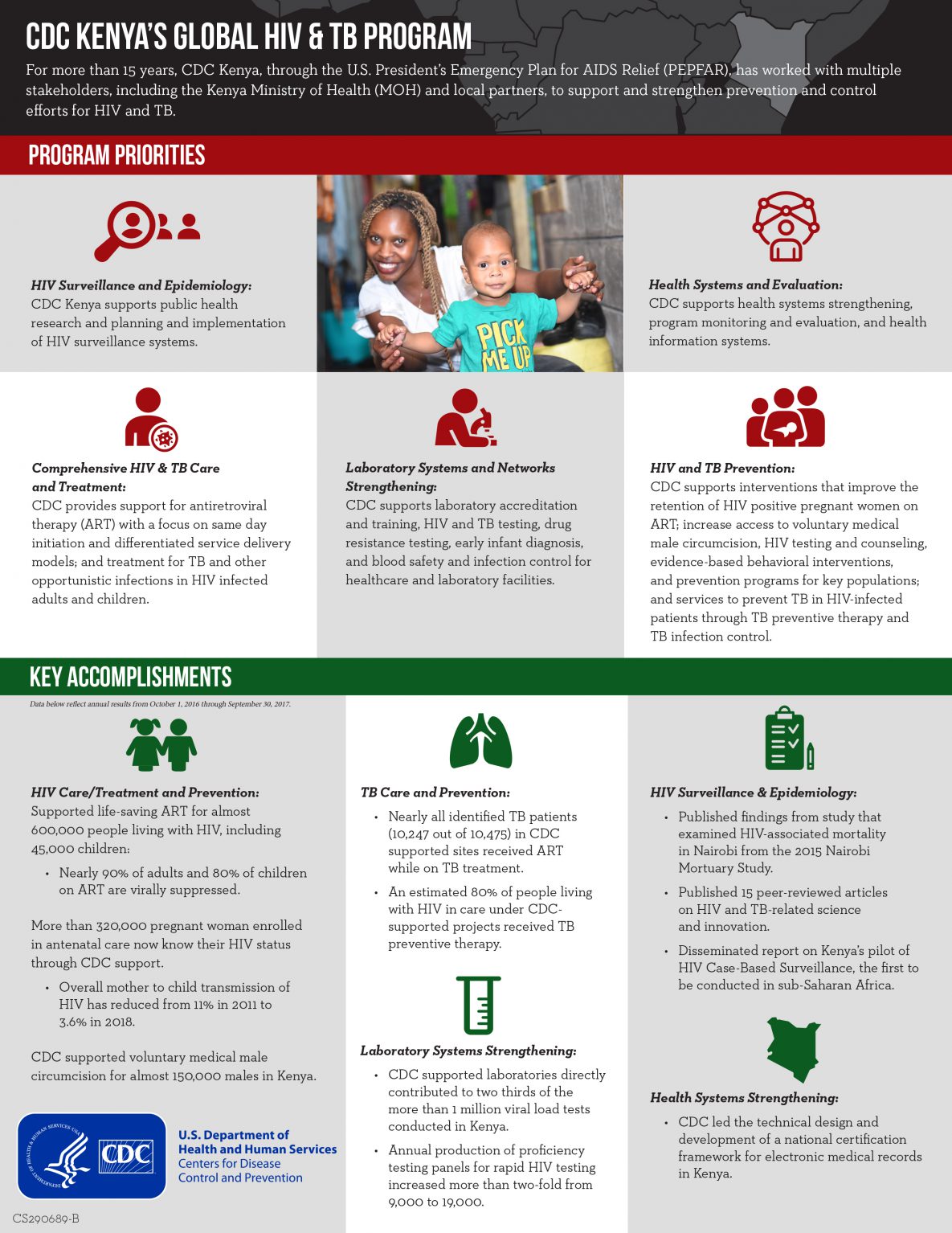CDC Kenya’s Global HIV & TB Program – Infographic

CDC Kenya’s Global HIV & TB Program
For more than 15 years, CDC Kenya, through the U.S. President’s Emergency Plan for AIDS Relief (PEPFAR), has worked with multiple
stakeholders, including the Kenya Ministry of Health (MOH) and local partners, to support and strengthen prevention and control
efforts for HIV and TB.
Program Priorities
Illustration of a magnifying glass looking at people
HIV Surveillance and Epidemiology: CDC Kenya supports public health research and planning and implementation of HIV surveillance systems.
Illustration of a person with a zoomed in circle
Comprehensive HIV & TB Care and Treatment: CDC provides support for antiretroviral therapy (ART) with a focus on same day initiation and differentiated service delivery models; and treatment for TB and other opportunistic infections in HIV infected adults and children.
Illustration of person looking through a microscope
Laboratory Systems and Networks Strengthening: CDC supports laboratory accreditation and training, HIV and TB testing, drug resistance testing, early infant diagnosis, and blood safety and infection control for healthcare and laboratory facilities.
Illustration of people with an infant in their care
HIV and TB Prevention: CDC supports interventions that improve the retention of HIV positive pregnant women on ART; increase access to voluntary medical male circumcision, HIV testing and counseling, evidence-based behavioral interventions, and prevention programs for key populations; and services to prevent TB in HIV-infected patients through TB preventive therapy and TB infection control.
Illustration of person looking at a network
Health Systems and Evaluation: CDC supports health systems strengthening, program monitoring and evaluation, and health information systems.
Key accomplishments
Data below reflect annual results from October 1, 2016 through September 30, 2017.
Illustration of children holding hands
HIV Care/Treatment and Prevention: Supported life-saving ART for almost 600,000 people living with HIV, including 45,000 children:
- Nearly 90% of adults and 80% of children on ART are virally suppressed.
More than 320,000 pregnant woman enrolled in antenatal care now know their HIV status through CDC support.
- Overall mother to child transmission of HIV has reduced from 11% in 2011 to 3.6% in 2018.
CDC supported voluntary medical male circumcision for almost 150,000 males in Kenya.
Illustration of lungs
TB Care and Prevention:
- Nearly all identified TB patients (10,247 out of 10,475) in CDC supported sites received ART while on TB treatment.
- An estimated 80% of people living with HIV in care under CDC supported projects received TB preventive therapy.
Illustration of test tube
Laboratory Systems Strengthening:
- CDC supported laboratories directly contributed to two thirds of the more than 1 million viral load tests conducted in Kenya.
- Annual production of proficiency testing panels for rapid HIV testing increased more than two-fold from 9,000 to 19,000.
Illustration of chart and pencil
HIV Surveillance & Epidemiology:
- Published findings from study that examined HIV-associated mortality in Nairobi from the 2015 Nairobi Mortuary Study.
- Published 15 peer-reviewed articles on HIV and TB-related science and innovation.
- Disseminated report on Kenya’s pilot of HIV Case-Based Surveillance, the first to be conducted in sub-Saharan Africa.
Illustration of a Kenya country outline
Health Systems Strengthening:
- CDC led the technical design and development of a national certification framework for electronic medical records in Kenya.